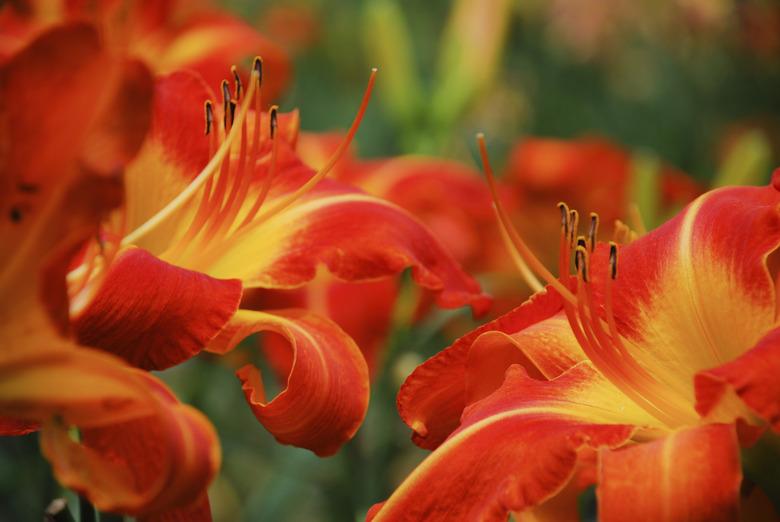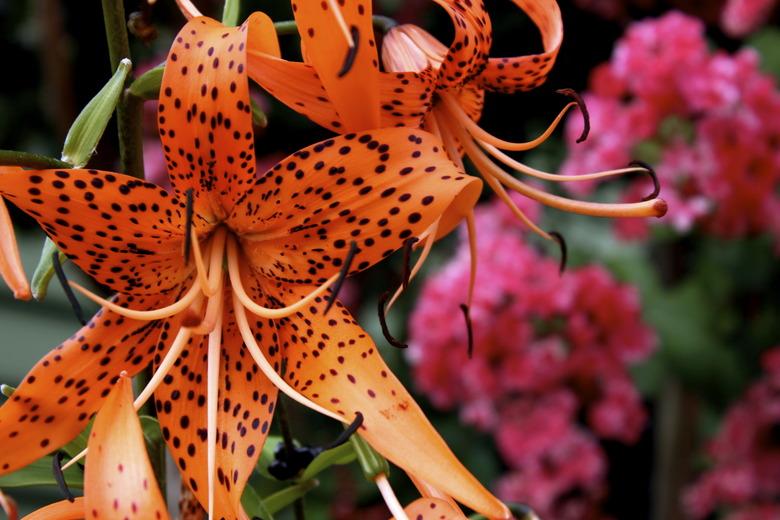What Is The Difference Between A Tiger Lily And A Daylily?
Daylilies (Hemerocallis spp.) and tiger lily (Lilium lancifolium, also Lilium tigrinum) have colorful, showy flowers and belong to the lily family. They differ in the shape and colors of the flowers, when they bloom, the growth habit of the plants and the root systems. Tiger lily is a single species thought native to eastern Asia, while daylilies contain a number of species, also native to Asia, that have many cultivars and hybrids.
Growth Form
Tiger lily is an upright plant, with an erect stem reaching 3 to 5 feet tall. Long, lance-shaped, dark green leaves extend horizontally from the stems. Young plants start out with just one stem, but older plants can have several stems.
In contrast, daylilies usually consist of a clump of arching, somewhat grass-like leaves coming from a common base. Foliage can be light to dark green and 18 to 24 inches high, depending on the variety. Flower stalks rise from the plant's center, and can be 12 to 36 inches tall, with several stalks per plant.
Flower Comparison
Tiger lily has downward-pointing, bright orange flowers with black dots on the petals. Numerous flowers appear on about the top one-third of the stem.
Daylilies generally have upward-facing, open trumpet-shaped flowers with flaring petals. Some cultivars have ruffled petals, double flowers or star-shaped or spider-shaped flowers. Daylilies come in a wide range of flower colors, including shades of yellow, pink, red, purple and melon. Some flowers have more than one color.
Root Growth
Tiger lily roots are fibrous and grow from the bottom of rounded bulbs.
Daylilies can have slender, fibrous roots or fleshy, tuberous roots. The area between the roots and the leaves on daylily plants is called the crown.
Growing Periods
Going dormant each fall, tiger lilies die back to the bulb for the winter.
The majority of daylily cultivars are also winter dormant, but a number of semi-evergreen and evergreen varieties exist.
Growing Conditions
Both kinds of lilies grow in full sun, with tiger lilies also tolerating woodland conditions. In hot summer areas, daylily flowers with dark colors do better with partial afternoon shade.
Both tiger lily and daylilies prefer well-drained soil and tolerate various soil types. Tiger lily prefers moist soil, and daylilies are drought- and heat-tolerant once established.
Tiger lilies are hardy in U.S. Department of Agriculture plant hardiness zones 4 through 9; daylilies are also generally hardy in USDA zones 4 through 9, with variation depending on the variety.
Garden Use
Tiger lily lends a stately air to borders and backgrounds. Plant it in front of tall evergreens, or use it as a backdrop for shorter flowering plants.
Daylilies can be massed for ground covers, used as borders, edgings and in rock gardens. Dwarf varieties grow well in containers.






